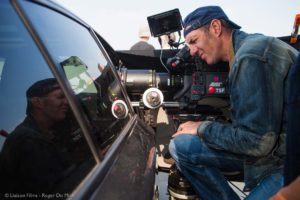A big theme in Hall 11 at IBC will be anamorphic production and new lenses. This is an excerpt of an article in the current issue of Film and Digital Times by Denis Rouden, AFC.
Miserere, starring Gérard Depardieu, Thierry Lhermitte and Joey Starr is a supernatural thriller about a policeman, about to retire, who searches for the murderer of a Paris church choir leader. Denis Rouden, AFC was the cinematographer. Sylvain White directed. Miserere had a budget of approximately €15 million.
We shot for 12 weeks in Paris, 1 month in Belgium, and 1 week in Morocco. When I first met with director Sylvain White, I said that I wanted to shoot with the new Alexa 4:3 and with Hawk 2x (4:3) anamorphic lenses. I like to shoot movies with Hawk anamorphic lenses: they are my current favorites.
The big breakthrough in digital cinematography was about using the 2x Hawk anamorphics on the ARRI Alexa with its 4:3 sensor. It permits “real” 2x anamorphic and not 1.3x, which is what we had to use with previous 16:9 sensors.
I was very interested to test this combination. I shot some tests and the images looked great. They were very different from what I had experienced with the Alexa Standard and Plus 16:9 sensor cameras. I showed the tests to the producer and director, and worked with Didier Le Fouest, the colorist at Digimage. The tests were lovely. The possibilities in color grading were great because the definition is better, there are more pixels being used with the full sensor, and you have the true anamorphic effect. So I asked Danys Bruyère and Thierry De Segonzac at TSF to buy 2 Alexa Studios for our production. I have a long history with TSF. We have been working together for a long time. I like Danys Bruyère: he is a friend, a very nice guy, he knows everything about all the equipment in the world, he knows cameras and grip and everything else. He’s a good guy when we need advice.
Alexa Studio was real progress. It was already a real revolution in digital cinema shooting with Alexa. For me, Alexa has been the best digital cinema camera. It provides my favorite picture. But, when you shoot in 16:9, with a 16:9 sensor, it’s a TV-size format. It’s OK, but it feels a little bit video-like. But when you shoot with a 4:3 sensor with anamorphic lenses, it’s wonderful, it’s real cinema like 35mm. You have more definition and the depth of field of 35mm anamorphic—it’s the same with 4-perf film and 4:3 Alexa digital. I find that composing the frame is better. I’m heading to Cape Town, South Africa to start my next feature, Zulu, and I will use the same combination again: Alexa and Hawk 2x anamorphic lenses.
Since June, you can use Alexa Plus with EVF and a 4:3 sensor. I think I will use both the Studio 4:3 and the Plus 4:3 cameras, and anamorphic Hawk lenses. It’s very nice to see the actors directly through the lens, through an optical viewfinder, like in 35mm, it’s more sensual. As opposed to an electronic viewfinder, which is like a small TV that lacks good color, good contrast: so I think the best for me is to have one each. One optical, one EVF, and sometimes an Alexa M.
I like the optical viewfinder, but you need to keep the shutter running—if you turn it off, you don’t have an image on the monitors. That’s the only problem for me. When the shutter is spinning, you lose a little light in the optical viewfinder. So sometimes, at night, it’s a little bit dark. For the next movie, I prefer to have a choice of OVF and EFV, because in the dark, I’d like to see all the details.
On Miserere I had 2 Alexa Studios most of the time. Natasza Chroscicki lent me the Alexa M camera for a week. I wanted to try it for shooting action fight scenes. It’s very light.
Production of Miserere started in beginning of January 2012. We started scouting and shooting tests. We screened some of those tests at Micro Salon in February. Those were the ones with Alexa Studio and Hawk lenses. And that was the first time I used Alexa with Hawks. After that, right before starting the film, we shot more tests around Paris with the actual Alexa and Hawks that we had on the movie, and also to show the Director and Didier le Fouest in the lab some ideas on color grading.
I think I made one movie with Panavision G-series anamorphics. It’s a different kind of look. The Hawk has a definition, a precision, that is very sharp, and flares that are very specific. It’s not the same flare as Panavision’s.
I used the Hawk V-Lite 45, 80 and 110mm; V-Plus 35, 50, 60, 100 and 135 mm; V-Series 30, 180 and 250 mm.
Also the Hawk 300-900 mm anamorphic zoom.
And, we used the 50-500 T5/1 (25-250 Angénieux with Kish Optics rear anamorphoser.)
But mostly the 50 mm Hawk—my favorite lens.
To match the 25-250 anamorphic with the Hawk primes, I needed a stop of T5.6 – 8 on the zoom, but not less, otherwise the picture would go a little soft. So I used the zoom mainly outside in daylight. For interiors, I used the Hawk V-Series 250 mm T3 anamorphic prime and the 180 mm T3. For my next movie, I will use the 48-580 T4 (24-290 Angenieux Optimo with rear anamorphoser.) ☐










actually, i shot the same combination in china, using two alexa studios, in china on MAN OF TAI CHI, that keanu reaves directed…started feb 2012 and finished end of july 2012……great experience….we also had da vinci on set color corecting, allowing full window capability; everything that da vinci is capable of…